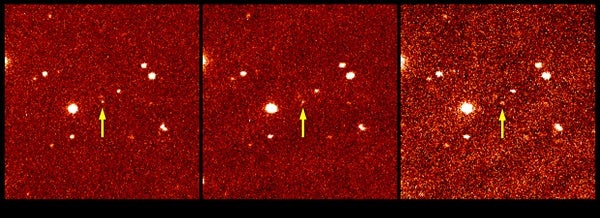“In the little cluster of orbs which scampers across the sidereal abyss under the name of the solar system there are, be it known, nine instead of a mere eight, worlds,” so came the announcement from Lowell Observatory in Flagstaff, Arizona on March 13, 1930.
The observatory’s revelation ignited not only the public’s imagination, but also the scientific community. And on the heels of Clyde Tombaugh’s Pluto discovery, many astronomers would eventually suggest that the planet might not be alone on our solar system’s fringes.
UCLA’s Fredrick C. Leonard was among the most prominent, when, in 1930, he wrote, “Is it not likely that in Pluto there has come to light the first of a series of ultra-Neptunian bodies, the remaining members of which still await discovery but which are destined eventually to be detected?”
Leonard used other groupings in the solar system to support his argument, pointing to the families of terrestrial planets, minor planets (like Ceres), and giant planets.
However, it was his understudy, Fred Whipple, who would carry the theory the farthest. Less than a month after the Pluto announcement, Whipple and fellow graduate student Ernest Bower used observations collected at Yerkes Observatory to calculate the new planet’s orbit at some 41 astronomical units (the average Earth-Sun distance is 1 AU) away.
This prompted Armin O. Leuschner, another of Whipple’s mentors, to tell the New York Times, “It may be one of many long-period planetary objects yet to be discovered, or a bright cometary object.”
Some 20 years later, Whipple published his “icy conglomerate” comet model, which entered common usage as the “dirty snowball” theory of how comets form. (Rosetta spacecraft observations in the aftermath of the Deep Impact mission would prove they’re actually more like “dirty iceballs.”) The astronomer’s seminal papers on the subject became the The Astrophysical Journal‘s most cited articles of the second half of the 20th century. And by the 1960s, he had returned for a more comprehensive treatment of Pluto’s family. The newest planet’s mass was still a mystery, and speculations made from misinterpretations of Neptune’s orbit led astronomers to guess a mass ranging from half that of Earth to 10 times more (its mass is actually less than 1 percent of Earth’s).
(Interestingly, history now notes that Kenneth Edgeworth made the first attempt to quantify a large body of comets in this region in 1943, but the Irish astronomer’s obscurity kept his publication from being noticed at the time.)
Instead, Whipple suggested a ring of comets and icy planetesimals that included Pluto might orbit in a disk some 40 to 60 AU from the Sun. And, in 1964, he became the first to attempt to estimate the mass of this region. But Pluto and comet orbits remained the only evidence for this group of trans-Neptunian objects. Whipple implored his colleagues to consider this potential region as they made observations.
Another major shift in the hunt for more Plutos came in 1980 when Julio Fernández of Uruguay’s University of the Republic suggested that comets entered our inner solar system far too often for them to originate in the far-flung Oort Cloud. Instead, he too suggested a belt of comets at 50 AU that also held Pluto-sized planets.
But the second Pluto proved more elusive and didn’t turn up until 1992. By the time it was, the world’s existence was well expected.
Next up: How a region proposed by many came to be called the Kuiper Belt.
Eric Betz is an associate editor of Astronomy. Follow him on Twitter: @EricBetz.










